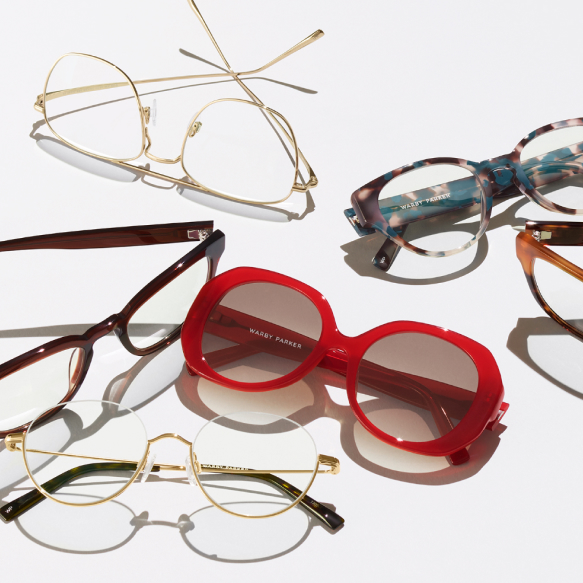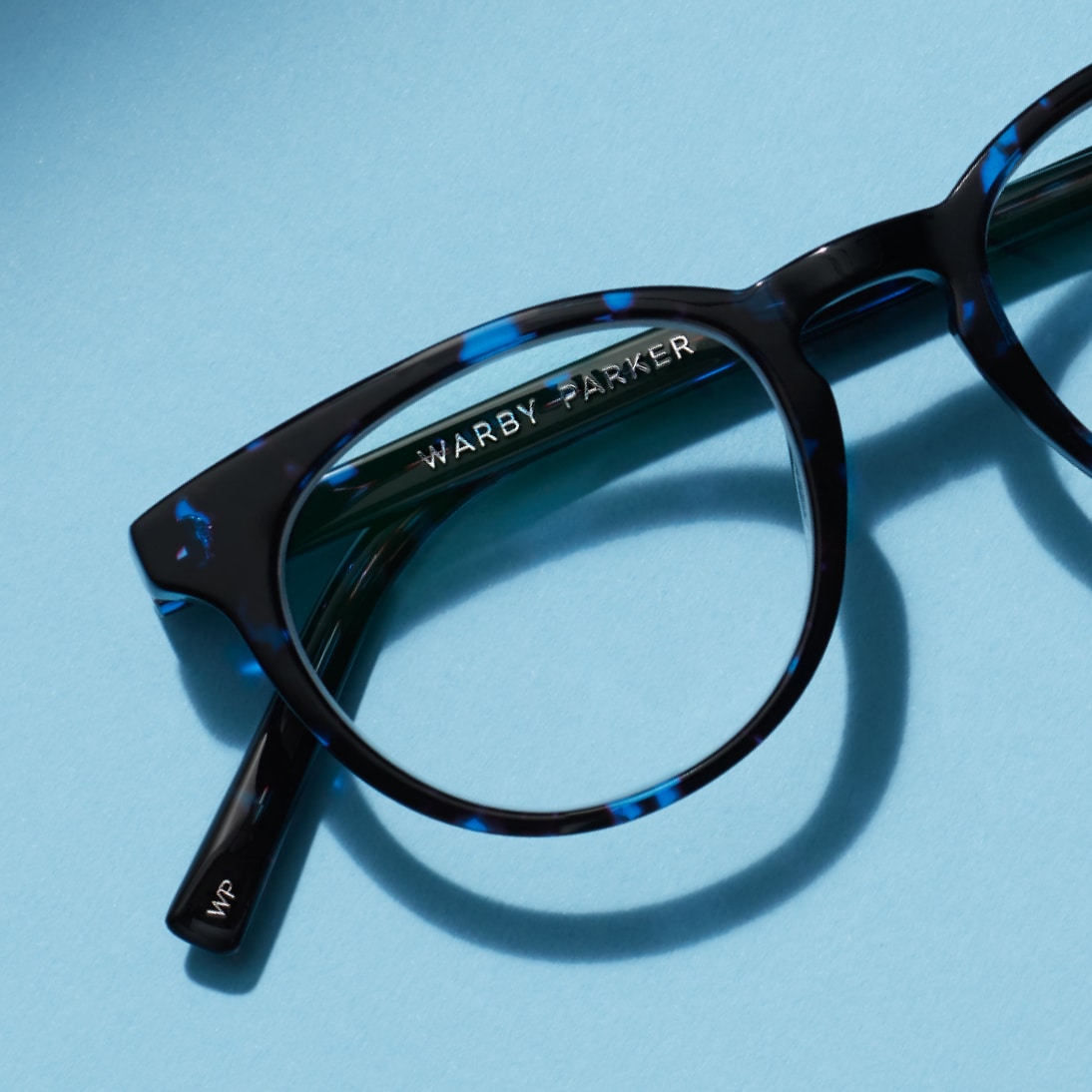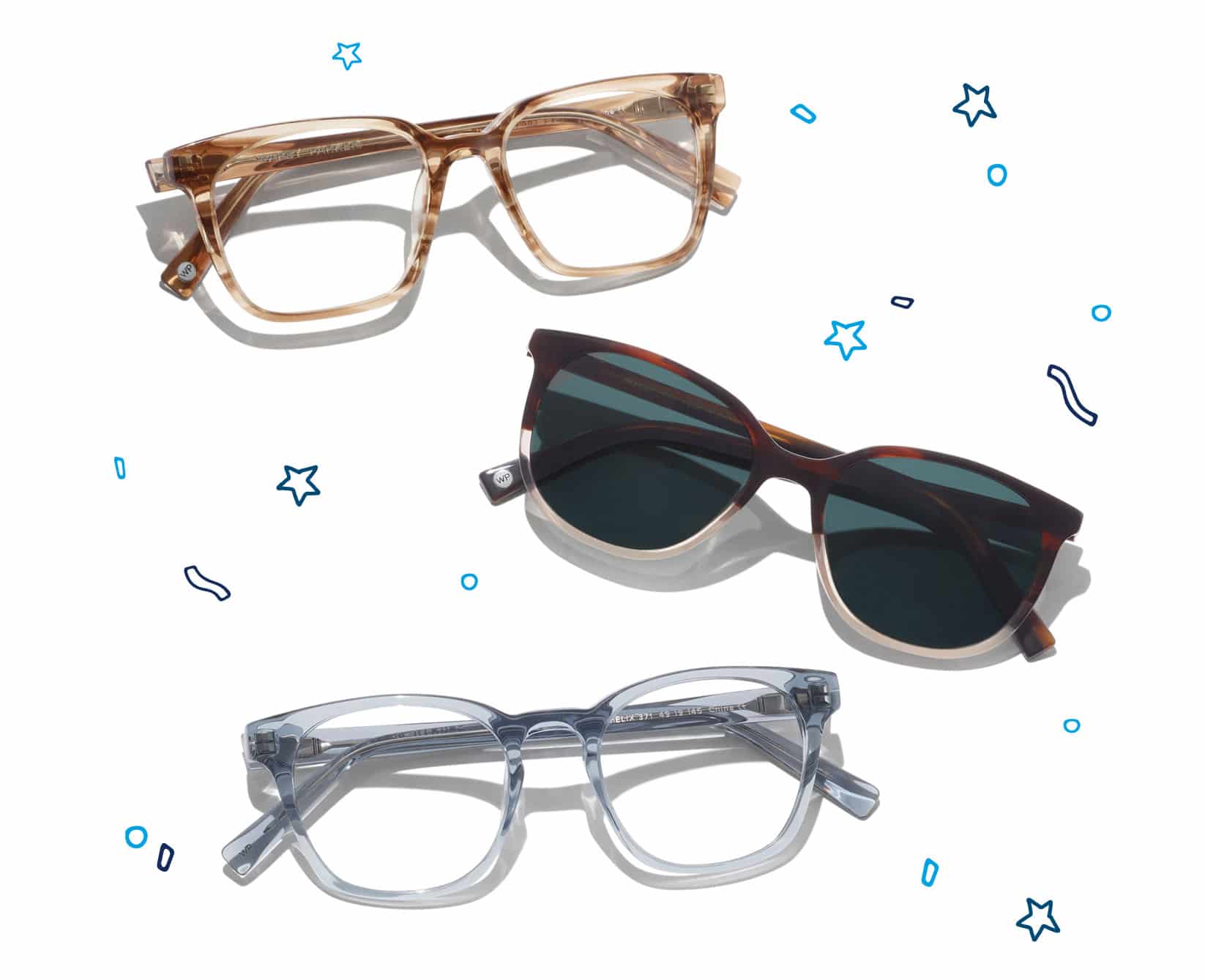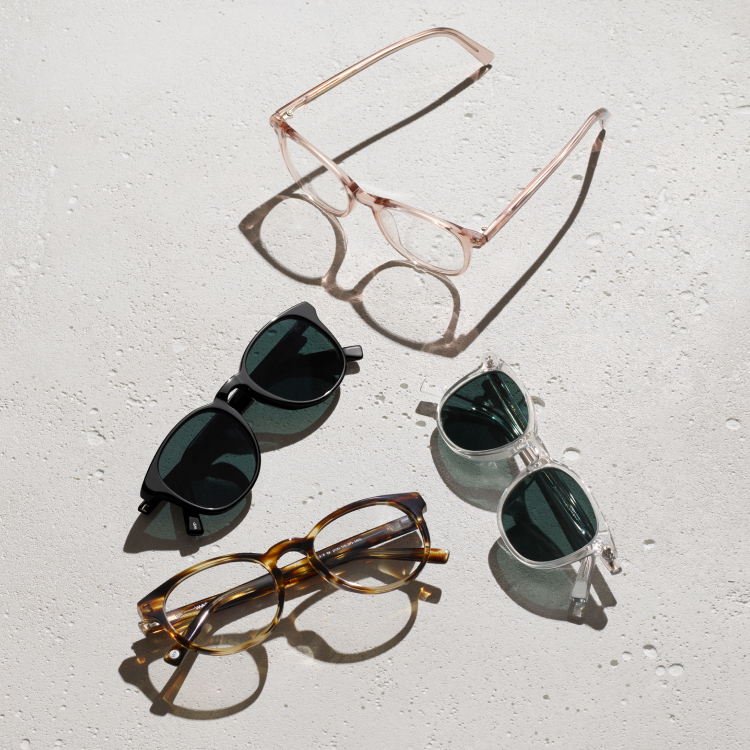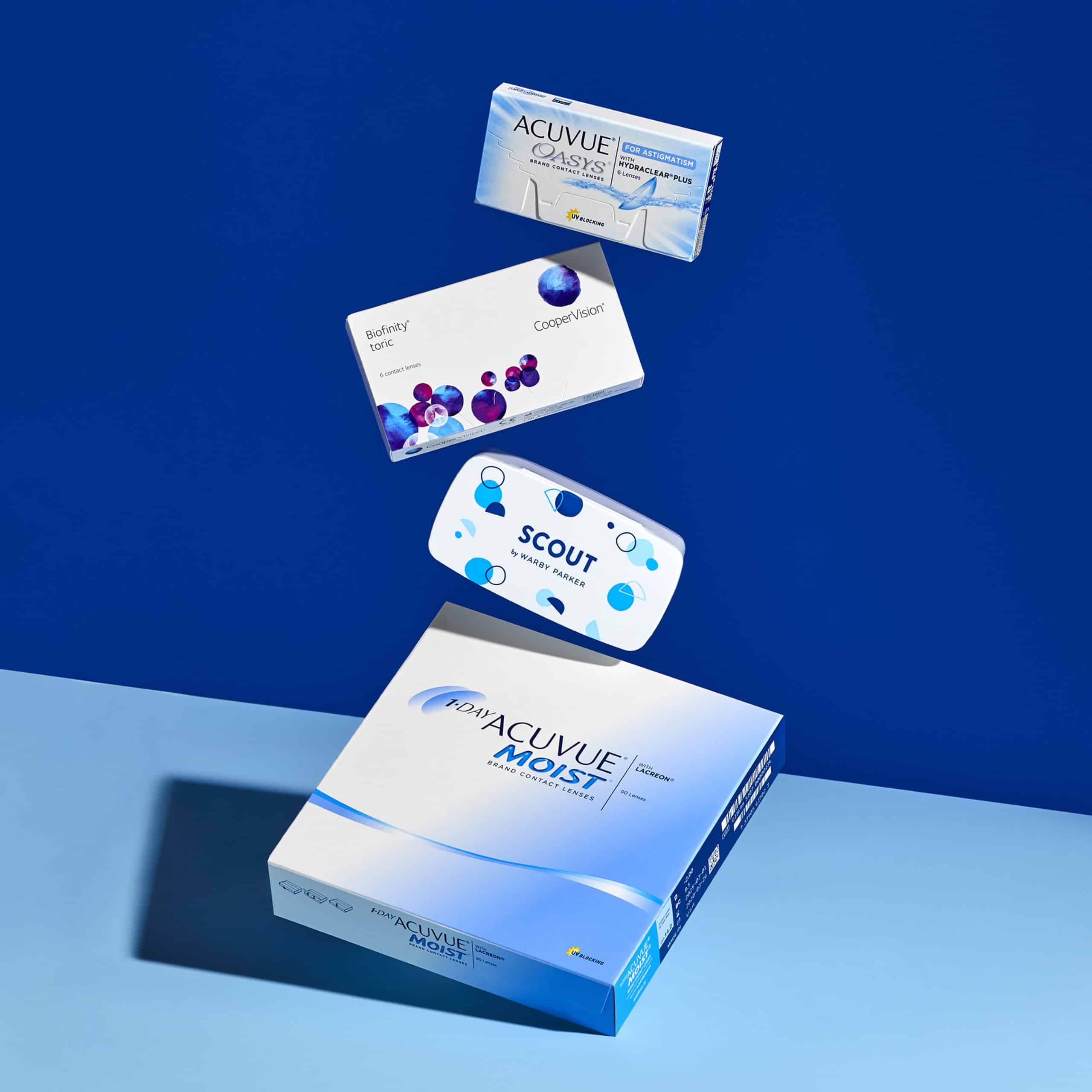The right lenses can quite literally make or break your glasses. They correct your vision, protect your eyes, and (with certain coatings) stand up to everything from scratches to UV rays.
But not every pair of glasses has the same type of lenses or lens materials. The best lenses for your glasses will depend on your prescription and unique visual needs, as well as whatever additional benefits you’d like to get from your glasses.
Let’s learn about different lens types and what they can offer your eyes.
Types of Optical Lenses for Vision Correction
If you wear prescription glasses or readers, your lenses refract light in a way that helps you see more clearly.
Up next are the most common types of eyeglass lenses designed for vision correction.
Single-Vision Lenses
Single-vision lenses correct for one field of vision—distance, computer or reading. Most single-vision prescription lenses result in a wider viewing area when compared to other lens styles. This lens type helps with eye conditions such as nearsightedness, farsightedness, and astigmatism.
Multifocal Lenses
Unlike single-vision lenses, multifocal lenses correct for more than one field of vision. Bifocal lenses are divided into two zones—one for distance vision and one for near vision. You can clearly see where each zone is on the lens, as they’re divided by a visible line.
Trifocal lenses are divided into three zones—one for distance vision, one for intermediate vision, and one for near vision. Like bifocals, trifocal lenses delineate their different zones with a visible line (but trifocals have two lines instead of one).
Progressive lenses are designed to correct for multiple viewing distances—including far, intermediate, and near—in one lens. They can therefore correct vision at almost any distance. Unlike other multifocal lens designs, progressives don’t have any visible lines or segments.
Anti-fatigue lenses include a single-vision prescription and a boost of magnification at the bottom of the lens. The lower part of the lens supports close-up vision by relaxing the eye muscle. This may make viewing digital devices and close-up work more comfortable over time, and it can help with eye strain caused by excessive screen time.
Prism Lenses
Sometimes eyes don’t move in alignment with one another, which can result in symptoms such as double vision or eye strain. (One example is a condition called strabismus, commonly known as “crossed eyes.”)
To account for this, your doctor may prescribe a prism correction to your optical lenses. The prism correction is placed in a certain position and orientation based on your prescription. The prism correction will have its own refractive strength, measured in prism diopters and base direction.
Spherical vs. Cylindrical Lenses
Spherical lenses correct refractive errors such as nearsightedness and farsightedness. These conditions occur when light focuses in front of or behind the retina instead of on the surface. Spherical lenses refocus light onto the retina’s surface to correct the refractive error.
Cylindrical lenses correct astigmatism, which causes light to focus on multiple points within the eye, rather than just one. Cylindrical lenses address the uneven curvature of the eye’s cornea and focus light properly for sharper sight.
Lens Materials
Lens material is a huge part of lens performance. Even though different eyeglass lenses might look very similar to one another, they can be made from a variety of plastics, each with different properties.
You might be wondering why material matters so much. The answer is twofold: The makeup of the lens determines both its index of refraction and its Abbe value.
Index of Refraction
The index of refraction (or refractive index) of a lens tells you how quickly light moves through it, compared to how quickly it would move through a vacuum. A high refractive index means the lens is quite good at refracting light quickly.
Determining the refractive index of a lens can look like a complex math equation involving the speed of light. However, all you need to know is that lenses with a high refractive index can be thinner than lenses with a lower refractive index while still achieving the same degree of refraction.
This is why eye professionals usually recommend lenses with high refractive indexes (most commonly 1.67 and 1.74) for people with stronger prescriptions. These lenses pack a lot of power into a thin, convenient package.
Abbe Value
The Abbe value of a lens measures how it disperses light and therefore the optical clarity of the lens.
If a lens has a low Abbe value, you might see colorful halos around objects and lights when looking through it. These chromatic aberrations can interfere with your sight and may cause distraction and irritation.
Lenses with high Abbe values, on the other hand, reduce the likelihood of these aberrations and provide clearer, uninterrupted vision.
Types of Plastic Lenses
These days, most eyeglass lenses are made from plastic instead of glass. Here are the most popular plastic lens types.
CR-39 Plastic Lenses
CR-39 plastic lenses came onto the scene in the 1940s as a more affordable and less weighty alternative to glass lenses. Not only are they less liable to shatter than their predecessors, but their Abbe value is a little less than 60—the highest of any plastic lens.
However, CR-39 plastic lenses can be a bit thicker than other plastic options and typically only accommodate weaker prescriptions. They are also not as impact-resistant as other materials.
Polycarbonate Lenses
Polycarbonate lenses have a higher refractive index than CR-39 lenses, so they’re more lightweight with better refractive efficiency. They’re also quite sturdy and impact-resistant. This quality makes them extra protective for your eyes, and optometrists often recommend them for children as well as adults. Polycarbonate lenses are the reliable staple of the lens world, and they come standard with all Warby Parker eyeglasses.
High-Index Lenses
High-index lenses are exactly what they sound like: plastic lenses with a high refractive index. That means they can correct stronger prescriptions without being too bulky (we recommend ours for prescriptions of +/-4.00 or higher). They usually cost a bit more than other types of glasses lenses.
Trivex Lenses
Trivex plastic lenses have a higher Abbe value than polycarbonate lenses. However, they become thicker than polycarbonate lenses with prescriptions over approximately +/- 3.00. Their biggest downside is their price, which pushes them into unaffordable territory for many.
Glass Lenses
You can still outfit your glasses with glass lenses—but just know you’re taking a risk. The extremely clear vision that glass provides is counterbalanced by its fragility and heaviness. If they break, glass lenses become dangerous and can injure your eyes and face. So most glasses providers no longer use this type of lens in their frames.
Types of Lens Coatings and Treatments
Once you’ve decided on your lens type and material, you can further customize your lenses with special coatings and treatments.
At Warby Parker, we include scratch-resistant, anti-reflective, and UV-blocking treatments with every pair of optical lenses. Other add-ons are more of a personal choice.
Scratch-resistant coating: This protects your lenses against minor surface scratches and abrasions, which can be both unsightly and inconvenient. (We’re so confident in ours that we’ll replace any scratched-up prescription lenses for free if you send them back within six months of purchase.)
Anti-reflective coating: Anti-reflective coating shields your eyes from glare and other harsh reflections. It’s part of all of our optical lenses, but it’s especially essential for high-index ones, because they tend to reflect more light.
Polarized lenses: Some sunglasses have polarized lenses, which further reduce glare and make both colors and contrasts pop. Polarized sunglasses are great for anyone who spends a lot of time outdoors, especially around lakes and oceans.
Hydrophobic coating: No one wants wet, smudgy lenses. A hydrophobic coating repels water so your lenses stay clear and clean.
UV-blocking treatment: Blocking out UVA and UVB rays helps prevent sunlight from damaging your eyes. (Our lenses block 100% of both, FYI.)
Blue-light-filtering treatment: If you use screens a lot (as most of us do), you might want to consider blue-light-filtering lenses. These types of lenses help filter blue light from screens and sunlight.
Light-responsive treatment: With this treatment, UV light turns clear lenses into photochromic—meaning they darken automatically in the sun, then go back to clear when indoors. Light-responsive lenses are great for people who want the convenience of prescription glasses and sunglasses in one frame. Often, these lenses come in a variety of lens colors. (You can outfit any of our frames with light-responsive lenses in brown, grey, or green.)
Lens Tints
Tinted lenses are another type of lens option. Some glasses have tinted lenses solely for style, whereas other tinted lenses have a designated purpose such as gaming, or helping with migraine symptoms or light sensitivity.
All sunglasses lenses are tinted to some degree, whether the tint is solid all across the lens or shaded in a gradient. The tint makes brightly lit environments much easier on your eyes. (Our prescription sunglasses come in five lens colors you can choose from at checkout.)
Different lens tints can filter out certain colors of light to help clarify vision and increase contrast. Common tints (and some of what they may do) include:
- Blue: Reduces glare and improves color perception both indoors and outside
- Brown: Helps prevent eye strain from digital devices, bright environments, and glare
- Grey: Preserves color accuracy while still shielding eyes from bright light
- Pink and red: Increases depth perception, which can be great for driving
- Yellow: Improves visual clarity in low light
Flash mirrored lenses: Another type of sunglasses lens, flash mirrored lenses guard your eyes against bright light and make your sunglasses look reflective. Mirrored lenses come in various colors, including blue, green, and rose gold.
How To Find the Best Lenses for Your Glasses
When choosing the best eyeglass lenses for you, it’s wise to consider everything from your prescription to the pricepoint to custom coatings that suit your lifestyle.
Your eye doctor and your optician are your greatest resources. They’ll be able to provide expert recommendations. For our part, we try to make the lens-picking process an easy one while you’re shopping for glasses online or in one of our stores.
But you’re the one who will be looking through the lenses—so try them out and see which type of lens feels like the most ideal match.

